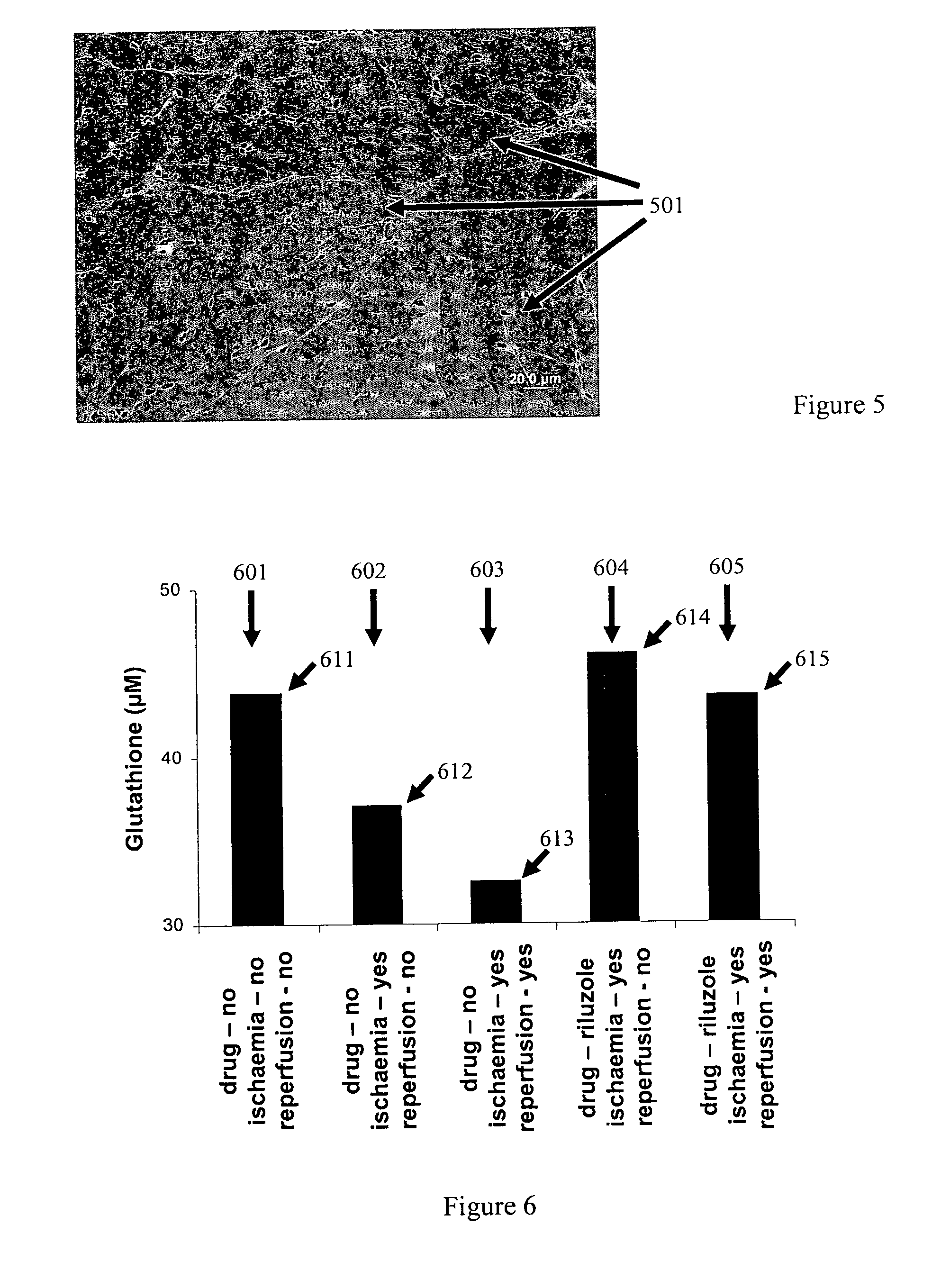Treatment of non-neuronal and non-myocardial cell, tissue and organ damage and associated pain with persistent sodium current blockers
a technology of non-neuronal and non-myocardial cells and sodium current blockers, which is applied in the direction of biocide, plant growth regulators, animal husbandry, etc., can solve the problems of treatment of such organs and further organ, tissue and cell damage and death
- Summary
- Abstract
- Description
- Claims
- Application Information
AI Technical Summary
Benefits of technology
Problems solved by technology
Method used
Image
Examples
example 1
[0129]Using H&E (hematoxylin and eosin) tissue staining, the tibialis anterior was studied in four groups of experimental animals: 1) with no damage and no treatment, 2) with ischaemia and reperfusion damage but no treatment, 3) with ischaemia damage and prior treatment with Riluzole, and 4) with ischaemia and reperfusion damage and prior treatment with Riluzole. In group 1) where there was no damage, there was minimal marbling of tissue as shown in FIG. 1. In group 2), there was extensive marbling of tissue indicative of extensive oedema as exemplified by the pale lines and regions such as those indicated at 201 in FIG. 2. Group 2) also showed extensive muscle waviness as exemplified by the wave-shapes in the tissue fibres at 301 in FIG. 3. Oedema and fibre waviness are both associated with extensive tissue damage and thus FIGS. 2 and 3 demonstrate considerable damage by ischaemia and reperfusion when compared with the non-damaged tissue shown in FIG. 1. In group 3), there was slig...
example 2
[0130]Persistent sodium current blockade was also evaluated for its effect on tissue glutathione levels during ischaemia and reperfusion. FIG. 6 shows a graph of average glutathione levels in each of five groups of experimental animals—those with no drug, no ischaemia and no reperfusion as shown at 601, those with no drug, with ischaemia and with no reperfusion as shown at 602, those with no drug, with ischaemia and with reperfusion as shown at 603, those with riluzole, with ischaemia and no reperfusion as shown at 604, and those with riluzole, with ischaemia and with reperfusion as shown at 605. As shown at 612, ischaemia alone in non-treated tissue significantly reduced the level of glutathione when compared with no ischaemia and no treatment at 611. Moreover, as shown at 613, reperfusion in non-treated tissue significantly reduced the level of glutathione when compared with ischaemia alone in non-treated tissue at 612 and when compared with no ischaemia and no treatment at 611. T...
example 3
[0131]In addition, persistent sodium current blockade was assessed for its affect on tissue DNA fragmentation during ischaemia and reperfusion. FIG. 7 shows 6 panels—701, 702, 703, 704, 705 and 706. Panels 701 and 702 are paired in that they show exactly the same section of tissue from the same animal. The difference between panels 701 and 702 is that they have been illuminated under different lighting conditions with panel 701 having been illuminated by light with wavelength greater than 620 nm, and panel 702 having been illuminated by light with wavelength around 520 nm. Similarly, panels 703 and 704 show the same section of tissue from the same animal with panel 703 having been illuminated by light with wavelength greater than 620 nm, and panel 704 having been illuminated by light with wavelength around 520 nm. In addition, panels 705 and 706 show the same section of tissue from the same animal with panel 705 having been illuminated by light with wavelength greater than 620 nm, a...
PUM
| Property | Measurement | Unit |
|---|---|---|
| wavelength | aaaaa | aaaaa |
| wavelength | aaaaa | aaaaa |
| wavelengths | aaaaa | aaaaa |
Abstract
Description
Claims
Application Information
 Login to View More
Login to View More - R&D
- Intellectual Property
- Life Sciences
- Materials
- Tech Scout
- Unparalleled Data Quality
- Higher Quality Content
- 60% Fewer Hallucinations
Browse by: Latest US Patents, China's latest patents, Technical Efficacy Thesaurus, Application Domain, Technology Topic, Popular Technical Reports.
© 2025 PatSnap. All rights reserved.Legal|Privacy policy|Modern Slavery Act Transparency Statement|Sitemap|About US| Contact US: help@patsnap.com



